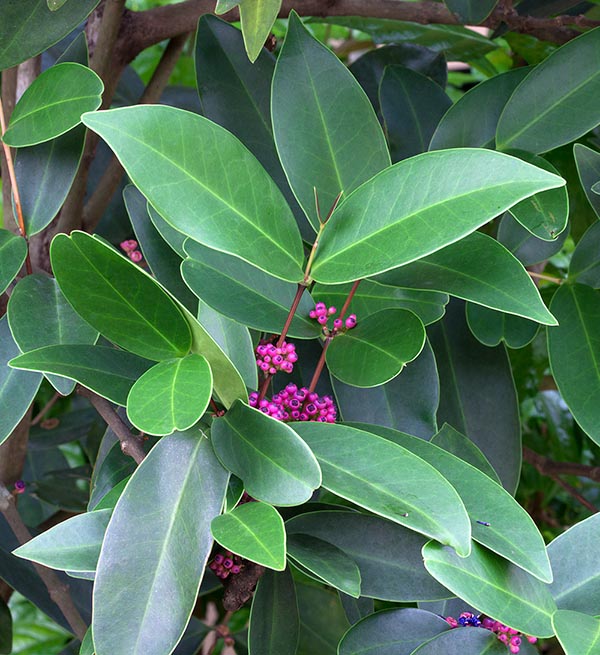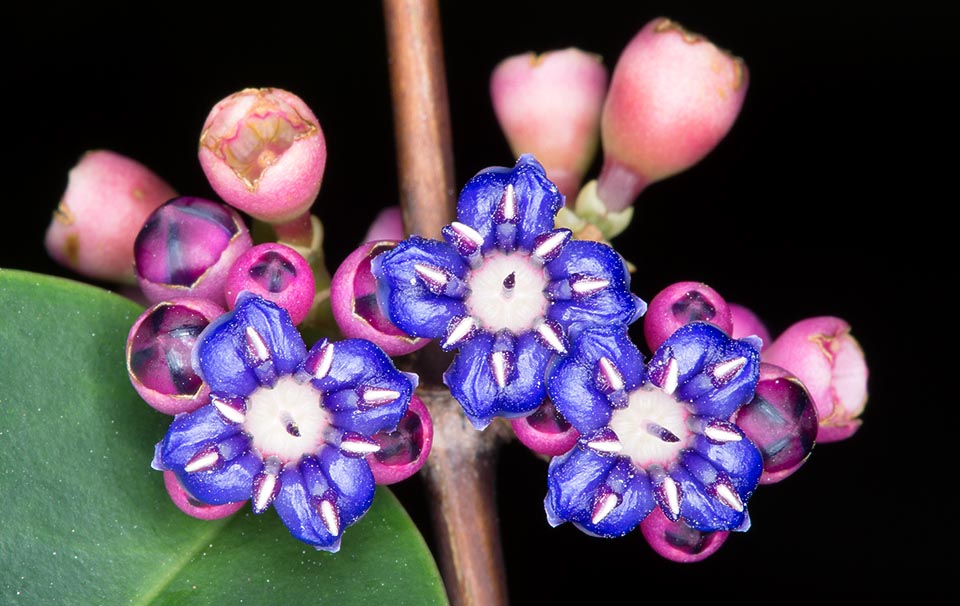Family : Melastomataceae

Text © Pietro Puccio

English translation by Mario Beltramini

The Memecylon caeruleum can be even 8 m tall in South-Eastern Asia © Giuseppe Mazza
The name of the genus is that given by Dioscorides (ca. 40-ca. 90) to the Arbutus unedo L.; the specific name is the Latin adjective “caeruleus, a, um” = light blue, with reference to the colour of the flowers.
Common names: blue strawberry flowers, Javanese nipis (English); phlong ka-ek (Cambodia); tian lan gu mu (China); delek jamu putih (Indonesia); delik-delik jambu, pokok nipis kulit (Malaysia); phlong khee khwaai, phlong khee nok, phlong khee tai (Thailand); sầm lam (Vietnam).
The Memecylon caeruleum Jack (1820) is a shrub or small evergreen tree, 3-8 m tall, with cylindrical trunk and smooth and brown bark in the young branches, wrinkly and greyish in the older ones. The leaves, on a 3-6 mm long petiole, are opposite, simple, oblong-elliptic with acute, obtuse or retuse apex and entire margin, 8-15 cm long and 3-6 cm broad, coriaceous, of dark green colour and glossy above.
Inflorescences, on a 0,5-1 cm long peduncle, axillar, compact, of 1,5-3 cm of diameter, carrying numerous tiny flowers with cup shaped hypanthium, 3-4 mm long, 4 sepals, 4 ovate petals, 2-3 mm long, of red colour externally, intense blue internally, and 8 stamens, about 2,5 mm long, of blue colour. Obovoid fruits, about 1,5 cm long and of 1 cm of diameter, initially of pink to red colour, then blackish purple or black when ripe, edible, usually containing only one seed immersed in a purple juicy pulp.
It easily reproduces by seed in fertile loam, with addition of sand per a 30% to improve the drainage, maintained humid at the temperature of 26-28 °C; it also propagates by cutting and by air layering.

The tiny flowers are the family jewels of the Melastomataceae: 8 stamens drawing a diamond on the intense blue of the petals, red externally © Giuseppe Mazza
It requires full sun or a slight shade and fertile soils, well drained, maintained almost constantly humid; it stands the moderately brackish soils and the marine aerosols, it can be therefore cultivated near to the sea.

Obovoid fruits, about 1,5 cm long and of 1 cm of diameter, initially pinkish, then blackish purple and black when ripe, are edible but of little value © Giuseppe Mazza
Synonyms: Memecylon floribundum Blume (1851); Memecylon cyanocarpum C.Y. Wu ex C. Chen (1979).
→ To appreciate the biodiversity within MELASTOMATACEAE family please click here.
